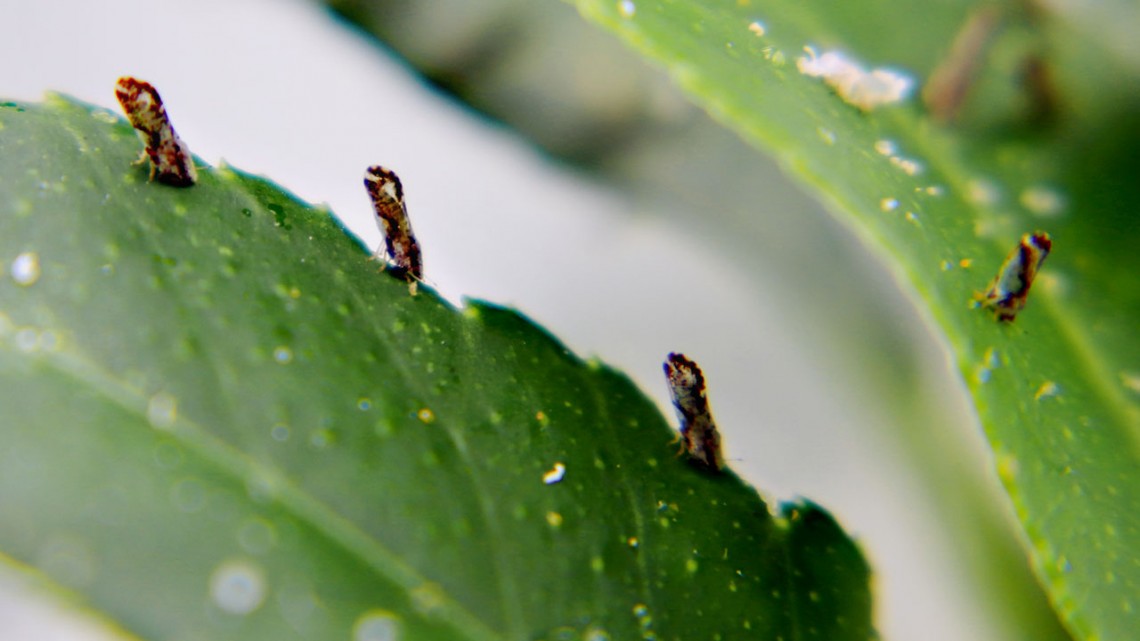
Asian citrus psyllids feed on a citrus tree. The psyllids deposit a bacterium in the sap that causes citrus greening disease, a scourge to the citrus industries in Florida and California, worth a combined $17 billion.
Psyllid peptides could fight citrus greening disease
By Michael J. Haas
Citrus greening disease, also called huanglongbing (HLB), is a bacterial infection of citrus trees that results in small, misshapen and sour fruits that are unsuitable for consumption. The disease ultimately kills the tree.
Because there is no cure, HLB is a major threat to the $10 billion citrus industry in Florida, where it was first detected in 2005, and to the $7 billion industry in California, where it appeared last year.
Researchers from the Boyce Thompson Institute (BTI), the U.S. Department of Agriculture Agricultural Research Service (USDA-ARS) and the University of Washington investigated a seemingly unlikely source of biocontrols for HLB: neuropeptides found in Asian citrus psyllids, the insect that carries the disease-causing bacterium Candidatus Liberibacter asiaticus (CLas), which it spreads while feeding on a tree’s leaves and stems.
The research team, led by BTI faculty member Michelle Heck, published its findings on Feb. 10 in the Journal of Proteome Research.
Laura Fleites, a research associate in Heck’s group at BTI, focused on neuropeptides because they function as hormones in hemipteran insects – a class that includes psyllids, aphids, whiteflies, shield bugs and other crop-plaguing species – to regulate growth, development and other biological functions.
“If we could develop an insecticide that is specific for Asian citrus psyllids based on one of the insect’s own neuropeptides, then we could protect citrus trees from the insect that spreads CLas,” said Heck, a USDA-ARS research molecular biologist and an adjunct associate professor in the School of Integrative Plant Science, in the College of Agriculture and Life Sciences. “Citrus greening disease is devastating our citrus industry, and we need to develop new ways for our citrus growers to control it.”
Fleites and the team characterized the full array of peptides found in the psyllids and identified 122 potential neuropeptides. While promising, the findings offer only potential starting points for combatting HLB, because unmodified insect-derived neuropeptides are not suited for use as insecticides in the citrus grove.
To turn the findings into a usable product, the team is now part of a collaboration aimed at identifying the best psyllid-derived neuropeptide for development. The team will then stabilize the peptide and decide the optimum method for delivering the insecticidal molecule to citrus trees – whether as a spray, by engineering trees to make the peptides themselves, or by some other method.
For the study, Fleites developed new extraction and analysis methods other researchers could use in their investigations of insect peptides.
“Thanks to USDA support, I was able to develop techniques that enable the identification of small, functional insect peptides separately from their larger, inactive precursors,” Fleites said. “Because these techniques aren’t specific to psyllids, they may be useful for identifying neuropeptides in other hemipteran insects to protect crop plants.”
Heck said this work shows how USDA grant programs can be used to fund everything from discovery to product development. The neuropeptide discovery was done in a study funded by the National Institute of Food and Agriculture; the translational research is being done under a grant from the Animal and Plant Health Inspection Service.
Funding for this work came from a USDA Specialty Crops Grant and from the USDA-ARS.
Michael J. Haas is a freelance writer for the Boyce Thompson Institute.
Media Contact
Get Cornell news delivered right to your inbox.
Subscribe
